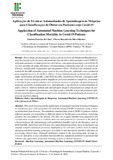| dc.relation | AMORIM, Lucas B.V. de; CAVALCANTI, George D.C.; CRUZ, Rafael M.O. The choice of scaling technique matters for classification performance. Applied Soft Computing, v. 133, p. 109924, 2023. ISSN 1568-4946. DOI: 10.1016/j.asoc.2022.109924. Disponível em: https://www.sciencedirect.com/science/article/abs/pii/S1568494622009735. Acesso em: 24 fev. 2025.
BERGSTRA, James; BENGIO, Yoshua. Random search for hyper-parameter optimization. Journal of Machine Learning Research, v. 13, p. 281–305, fev. 2012. Disponível em: https://www.jmlr.org/papers/volume13/bergstra12a/bergstra12a.pdf. Acesso em: 24 fev. 2025.
BEYER, H. Tukey, John W.: Exploratory Data Analysis. Addison-Wesley Publishing Company Reading, Mass. — Menlo Park, Cal., London, Amsterdam, Don Mills, Ontario, Sydney 1977, XVI, 688 p. Biometrical Journal, v. 23, n. 4, p. 413–414, 1981. DOI: 10.1002/bimj.4710230408. Disponível em: https://onlinelibrary.wiley.com/doi/abs/10.1002/bimj.4710230408. Acesso em: 24 fev. 2025.
BREIMAN, Leo. Random Forests. Machine Learning, v. 45, p. 5–32, out. 2001. DOI: 10.1023/A:1010950718922. Disponível em: https://www.researchgate.net/publication/275342330_Random_Forests. Acesso em: 24 fev. 2025.
CHEN, Tianqi; GUESTRIN, Carlos. XGBoost: A scalable tree boosting system. In: PROCEEDINGS of the 22nd ACM SIGKDD International Conference on Knowledge Discovery and Data Mining. [S.l.: s.n.], 2016. p. 785–794. Disponível em: https://arxiv.org/abs/1603.02754. Acesso em: 24 fev. 2025.
DOMINGOS, Pedro. A few useful things to know about machine learning. Communications of the ACM, v. 55, n. 10, p. 78–87, 2012. Disponível em: https://dl.acm.org/doi/10.1145/2347736.2347755. Acesso em: 24 fev. 2025.
ERICKSON, Nick et al. AutoGluon-Tabular: Robust and Accurate AutoML for Structured Data. arXiv preprint arXiv:2003.06505, 2020. Disponível em: https://arxiv.org/abs/2003.06505. Acesso em: 24 fev. 2025.
FEURER, Matthias et al. Efficient and Robust Automated Machine Learning. In: Advances in Neural Information Processing Systems. [S.l.]: Curran Associates, Inc., 2015. v. 28.
FREUND, Yoav; SCHAPIRE, Robert E. A Decision-Theoretic Generalization of On-Line Learning and an Application to Boosting. J. Comput. Syst. Sci., v. 55, n. 1, p. 119–139, 1997. DOI: 10.1006/jcss.1997.1504. Disponível em: https://doi.org/10.1006/jcss.1997.1504. Acesso em: 24 fev. 2025.
FRIEDMAN, Jerome H. Greedy function approximation: A gradient boosting machine. The Annals of Statistics, v. 29, n. 5, p. 1189–1232, 2001. DOI: 10.1214/aos/1013203451. Disponível em: https://doi.org/10.1214/aos/1013203451. Acesso em: 24 fev. 2025.
GIJSBERS, Pieter et al. An Open Source AutoML Benchmark. CoRR, v. 1907.00909, 2019. arXiv: 1907.00909. Disponível em: http://arxiv.org/abs/1907.00909. Acesso em: 24 fev. 2025.
Instituto Federal de Educação, Ciências e Tecnologia de Pernambuco. Campus Paulista. Curso de Análise e Desenvolvimento de Sistemas. 31 de janeiro de 2025.
HARRIS, Charles R. et al. Array programming with NumPy. Nature, v. 585, n. 7825, p. 357–362, 2020. DOI: 10.1038/s41586-020-2649-2. Disponível em: https://doi.org/10.1038/s41586-020-2649-2. Acesso em: 24 fev. 2025.
HASTIE, Trevor; TIBSHIRANI, Robert; FRIEDMAN, Jerome. The Elements of Statistical Learning: Data Mining, Inference, and Prediction. [S.l.]: Springer, 2009. (Springer Series in Statistics). DOI: 10.1007/978-0-387-84858-7. Disponível em: https://doi.org/10.1007/978-0-387-84858-7. Acesso em: 24 fev. 2025.
HE, Xin; ZHAO, Kaiyong; CHU, Xiaowen. AutoML: A survey of the state-of-the-art. Knowledge-Based Systems, Elsevier BV, v. 212, p. 106622, jan. 2021. ISSN 0950-7051. DOI: 10.1016/j.knosys.2020.106622. Disponível em: http://dx.doi.org/10.1016/j.knosys.2020.106622. Acesso em: 24 fev. 2025.
HOSMER, David W.; LEMESHOW, Stanley; STURDIVANT, Rodney X. Applied Logistic Regression. [S.l.]: John Wiley & Sons, Inc, 2000. ISBN 978-0-471-72214-4. DOI: 10.1002/0471722146.
HUTTER, Frank; KOTTHOFF, Lars; VANSCHOREN, J. (Ed.). Automatic machine learning: methods, systems, challenges. Alemanha: Springer, 2019. (Challenges in Machine Learning). ISBN 978-3-030-05317-8. DOI: 10.1007/978-3-030-05318-5.
KUNCHEVA, Ludmila. Combining Pattern Classifiers: Methods and Algorithms: Second Edition. [S.l.]: John Wiley & Sons, ago. 2014. v. 47. ISBN 978-1-118-91456-4. DOI: 10.1002/0471660264.
LEDELL, Erin; POIRIER, Sebastien. H2O AutoML: Scalable automatic machine learning. In: ICML SAN DIEGO, CA, USA. Proceedings of the AutoML Workshop at ICML. [S.l.: s.n.], 2020. Disponível em: https://www.automl.org/wp-content/uploads/2020/07/AutoML_2020_paper_61.pdf. Acesso em: 24 fev. 2025.
OOMS, Richard; SPRUIT, Marco. Self-Service Data Science in Healthcare with Automated Machine Learning. Applied Sciences, v. 10, p. 2992, abr. 2020. DOI: 10.3390/app10092992. Disponível em: https://www.mdpi.com/2076-3417/10/9/2992. Acesso em: 24 fev. 2025.
PALADINO, L. M. et al. Evaluating the performance of automated machine learning (AutoML) tools for heart disease diagnosis and prediction. AI, v. 4, p. 1036–1058, 2023. DOI: 10.3390/ai4040053. Disponível em: https://www.mdpi.com/2673-2688/4/4/53. Acesso em: 24 fev. 2025.
POL, Urmila; MOHAREKAR, Tejashree. AutoML: Building a classification model with PyCaret. Ymer, v. 20, p. 547–552, dez. 2021. Disponível em: https://www.researchgate.net/publication/356749319_AutoML_Building_An_Classification_Model_With_Pycaret. Acesso em: 24 fev. 2025.
THIRUNAVUKARASU, Arun James et al. Clinical performance of automated machine learning: a systematic review. medRxiv, Cold Spring Harbor Laboratory Press, 2023. DOI: 10.1101/2023.10.26.23297599. Disponível em: https://www.medrxiv.org/content/10.1101/2023.10.26.23297599v1. Acesso em: 24 fev. 2025.
TRUONG, Anh et al. Towards Automated Machine Learning: Evaluation and Comparison of AutoML Approaches and Tools. CoRR, v. 1908.05557, 2019. arXiv: 1908.05557. Disponível em: http://arxiv.org/abs/1908.05557. Acesso em: 24 fev. 2025.
WERTH, Alexandra et al. Engagement in collaboration and teamwork using Google Colaboratory. In: 2022 Physics Education Research Conference Proceedings. [S.l.: s.n.], set. 2022. p. 481–487. DOI: 10.1119/perc.2022.pr.Werth. Disponível em: https://ui.adsabs.harvard.edu/abs/2022perc.conf..481W. Acesso em: 24 fev. 2025.
WYNANTS, L. et al. Prediction models for diagnosis and prognosis of COVID-19: systematic review and critical appraisal. BMJ, v. 369, p. m1328, 2020. Disponível em: https://www.bmj.com/content/369/bmj.m1328. Acesso em: 24 fev. 2025.
YANG, J.; SHI, R.; NI, B. MedMNIST Classification Decathlon: A Lightweight AutoML Benchmark for Medical Image Analysis. CoRR, v. 2010.14925, 2020. arXiv: 2010.14925. Disponível em: https://arxiv.org/abs/2010.14925. Acesso em: 24 fev. 2025.
ZÖLLER, Marc-André; HUBER, Marco F. Benchmark and Survey of Automated Machine Learning Frameworks. Journal of Artificial Intelligence Research, v. 1904.12054, p. 409–472, 2021. Disponível em: http://arxiv.org/abs/1904.12054. Acesso em: 24 fev. 2025. | pt_BR |


